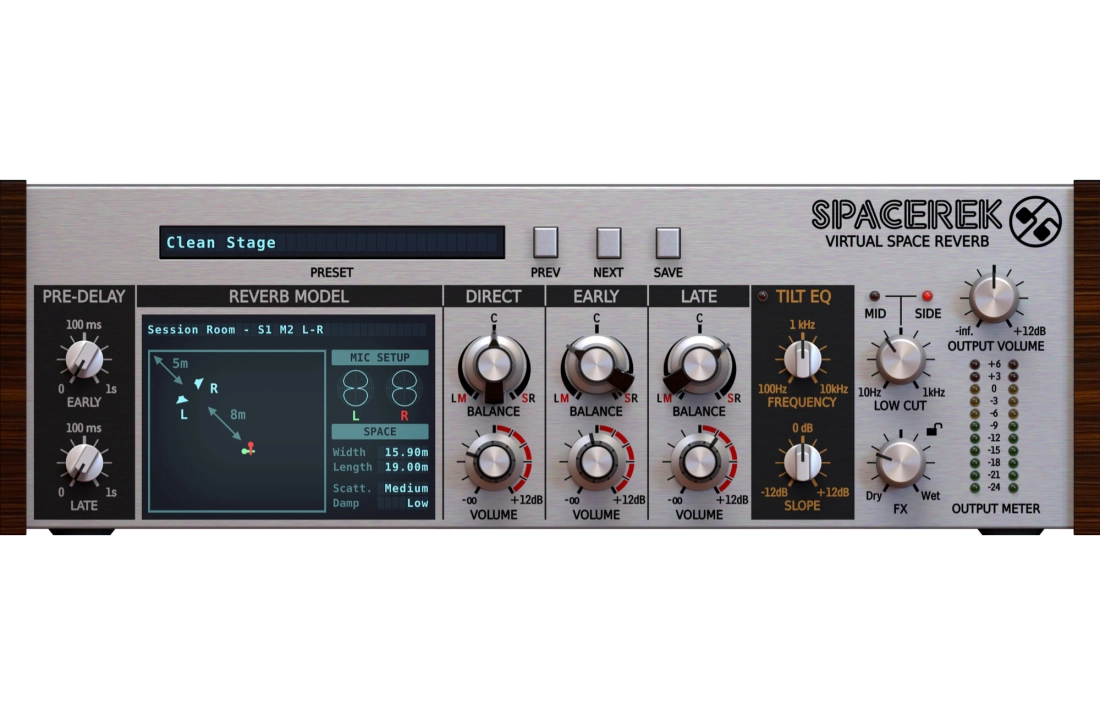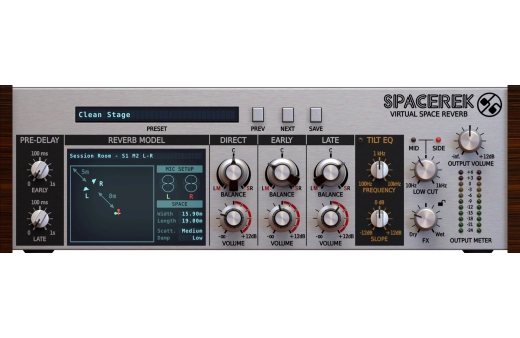Opens in a new window
D16 Spacerek Virtual Space Reverb - Download

Buy Online
In Stock
This product is delivered by download. Once your payment has been approved your software license will be sent to you via email. The download link for your purchase will be included with your license.
Software Is Not Returnable
Early reflections are generated through painstakingly accurate simulation of a diverse range of real-world spaces, and the positioning of speakers and microphones within them.
The hybrid algorithm at the heart of Spacerek fuses modelled virtual spaces to a dynamic delay network, generating reverb tails with supremely realistic early reflections, dense, colourful late reflections, and separately adjustable ER and LR pre-delay times. Dozens of emulated room types take in halls, towers, chambers, tunnels and much more, and each one integrates a variety of preset stereo microphone and speaker setups. Spacerek also makes balancing the Direct signal, Early reflections and Late reflections easy with its three-channel mixer; while the highly musical Tilt EQ and Low Cut filter modules provide effortless shaping of the overall tail. And as each Reverb Model is pre-configured for left-right or mid-side stereo operation, tweaking width and spatialisation is a snap.
Spacerek doesn't put the squeeze on your system, either indeed, when you hear it, you can't fail to be impressed by its CPU-friendliness (compared with typical audio simulation techniques).
Pre-Delay
Independent Early and Late reflection Pre-Delay controls allow up to 1 second of start time offset to be applied to each, adjustable in nanoseconds, microseconds and milliseconds.
Reverb Model
Spacerek's expansive roster of modelled rooms lets you summon up vivid virtual stages of many kinds from booths, chambers and halls to tunnels, chapels and towers and switch between them at a click. Each room takes in multiple microphone and speaker configurations, too, for a total of 114 different Reverb Models, covering all your mixing and sound design bases.
Early Reflections
Early reflections are generated by our proprietary Virtual Space Reverb engine, which simulates a diverse array of real-world spaces with painstaking accuracy. Each Reverb Model defines not only the acoustic properties of the space it represents, but also the positioning of the stereo speakers and microphones used to send the source signal through that space, for even greater environmental realism and versatility.
Late Reflections
The late reflections are built up by a responsive dynamic delay network, which blends seamlessly with the Virtual Space Reverb's early reflections to create an incredibly natural sounding reverb tail. And despite the quality and complexity of the acoustic modelling involved, Spacerek's innovative, optimized hybrid design keeps CPU usage lower than you might expect.
Tilt EQ and Low Cut Filter
Two stages of musical frequency shaping enable tonal customization of the tail, for applying those crucial finishing touches to your reverb. The Tilt EQ provides instant boosting of lows or highs, while the Low Cut filter is ideal for clearing mud and rumble out of the mid and/or side signals.
System Requirements:
Windows PC
OS version: Win 7, Win 8, Win 10
CPU: 3.4 Ghz SSE (Multicore 4.0 GHz recommended)
RAM: 8 GB (16 GB Recommended)
Software: VST2 / AAX compatible host application (32bit or 64bit)
Apple Mac
OS version: OS X 10.9 to macOS X 12
CPU: Intel based 2.8 GHz (i7 based 3.4 GHz recommended), Apple silicon
RAM: 8 GB (16 GB Recommended)
Software: AU / VST2 / VST3 / AAX compatible host application (64bit only!)
The hybrid algorithm at the heart of Spacerek fuses modelled virtual spaces to a dynamic delay network, generating reverb tails with supremely realistic early reflections, dense, colourful late reflections, and separately adjustable ER and LR pre-delay times. Dozens of emulated room types take in halls, towers, chambers, tunnels and much more, and each one integrates a variety of preset stereo microphone and speaker setups. Spacerek also makes balancing the Direct signal, Early reflections and Late reflections easy with its three-channel mixer; while the highly musical Tilt EQ and Low Cut filter modules provide effortless shaping of the overall tail. And as each Reverb Model is pre-configured for left-right or mid-side stereo operation, tweaking width and spatialisation is a snap.
Spacerek doesn't put the squeeze on your system, either indeed, when you hear it, you can't fail to be impressed by its CPU-friendliness (compared with typical audio simulation techniques).
Pre-Delay
Independent Early and Late reflection Pre-Delay controls allow up to 1 second of start time offset to be applied to each, adjustable in nanoseconds, microseconds and milliseconds.
Reverb Model
Spacerek's expansive roster of modelled rooms lets you summon up vivid virtual stages of many kinds from booths, chambers and halls to tunnels, chapels and towers and switch between them at a click. Each room takes in multiple microphone and speaker configurations, too, for a total of 114 different Reverb Models, covering all your mixing and sound design bases.
Early Reflections
Early reflections are generated by our proprietary Virtual Space Reverb engine, which simulates a diverse array of real-world spaces with painstaking accuracy. Each Reverb Model defines not only the acoustic properties of the space it represents, but also the positioning of the stereo speakers and microphones used to send the source signal through that space, for even greater environmental realism and versatility.
Late Reflections
The late reflections are built up by a responsive dynamic delay network, which blends seamlessly with the Virtual Space Reverb's early reflections to create an incredibly natural sounding reverb tail. And despite the quality and complexity of the acoustic modelling involved, Spacerek's innovative, optimized hybrid design keeps CPU usage lower than you might expect.
Tilt EQ and Low Cut Filter
Two stages of musical frequency shaping enable tonal customization of the tail, for applying those crucial finishing touches to your reverb. The Tilt EQ provides instant boosting of lows or highs, while the Low Cut filter is ideal for clearing mud and rumble out of the mid and/or side signals.
System Requirements:
Windows PC
OS version: Win 7, Win 8, Win 10
CPU: 3.4 Ghz SSE (Multicore 4.0 GHz recommended)
RAM: 8 GB (16 GB Recommended)
Software: VST2 / AAX compatible host application (32bit or 64bit)
Apple Mac
OS version: OS X 10.9 to macOS X 12
CPU: Intel based 2.8 GHz (i7 based 3.4 GHz recommended), Apple silicon
RAM: 8 GB (16 GB Recommended)
Software: AU / VST2 / VST3 / AAX compatible host application (64bit only!)
Q & A
There are currently no questions for this product.
Reviews
There are currently no reviews for this product. Be the first to write one!





